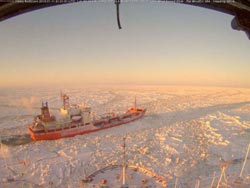TacSat-4 Enables Polar Region SatCom Experiment

The USCG cutter HEALY (WAGB-20) escorts Russian fuel tanker Renda in Alaska's Bering Sea, Jan. 11, 2012. (United States Coast Guard) <br>
Returning from an escort and icebreaking mission to Nome, Alaska, assisting the Russian tanker Renda delivery of emergency fuel to the town, the USCGC HEALY — Coast Guard's only polar icebreaker — was approximately 260 nautical miles south of the Arctic Circle at the time of the test.
Deployed into a unique, highly elliptical orbit with an apogee of 12,050 kilometers, TacSat-4 helps augment current geosynchronous satellite communication by including the high latitudes. The experiment was the first in a series of planned steps that aim to demonstrate TacSat-4's utility in the polar and arctic regions.
Also participating in communications with the HEALY was the Army Space and Missile Defense Battle Lab (SMDBL) located in Colorado Springs, Col. The SMDBL team was conducting portions of the ongoing TacSat-4 Joint Military Utility Assessment (JMUA).
Managed by the U.S. Naval Research Laboratory, Naval Center for Space Technology, TacSat-4 is an experimental spacecraft that will test advances in several technologies and SATCOM techniques. It will augment the existing fleet with an additional space asset to provide communications to otherwise under-served users and areas that either do not have high enough priority or do not have satellite visibility.
The Office of Naval Research (ONR) is funding the first year of TacSat-4 operations. The Operationally Responsive Space (ORS) Office is leading and funding the JMUA of TacSat-4.
About the U.S. Naval Research Laboratory
The U.S. Naval Research Laboratory is the Navy's full-spectrum corporate laboratory, conducting a broadly based multidisciplinary program of scientific research and advanced technological development. The Laboratory, with a total complement of nearly 2,500 personnel, is located in southwest Washington, D.C., with other major sites at the Stennis Space Center, Miss., and Monterey, Calif. NRL has served the Navy and the nation for over 85 years and continues to meet the complex technological challenges of today's world. For more information, visit the NRL homepage or join the conversation on Twitter, Facebook, and YouTube.
Media Contact
More Information:
http://www.nrl.navy.milAll latest news from the category: Earth Sciences
Earth Sciences (also referred to as Geosciences), which deals with basic issues surrounding our planet, plays a vital role in the area of energy and raw materials supply.
Earth Sciences comprises subjects such as geology, geography, geological informatics, paleontology, mineralogy, petrography, crystallography, geophysics, geodesy, glaciology, cartography, photogrammetry, meteorology and seismology, early-warning systems, earthquake research and polar research.
Newest articles

High-energy-density aqueous battery based on halogen multi-electron transfer
Traditional non-aqueous lithium-ion batteries have a high energy density, but their safety is compromised due to the flammable organic electrolytes they utilize. Aqueous batteries use water as the solvent for…

First-ever combined heart pump and pig kidney transplant
…gives new hope to patient with terminal illness. Surgeons at NYU Langone Health performed the first-ever combined mechanical heart pump and gene-edited pig kidney transplant surgery in a 54-year-old woman…

Biophysics: Testing how well biomarkers work
LMU researchers have developed a method to determine how reliably target proteins can be labeled using super-resolution fluorescence microscopy. Modern microscopy techniques make it possible to examine the inner workings…





















